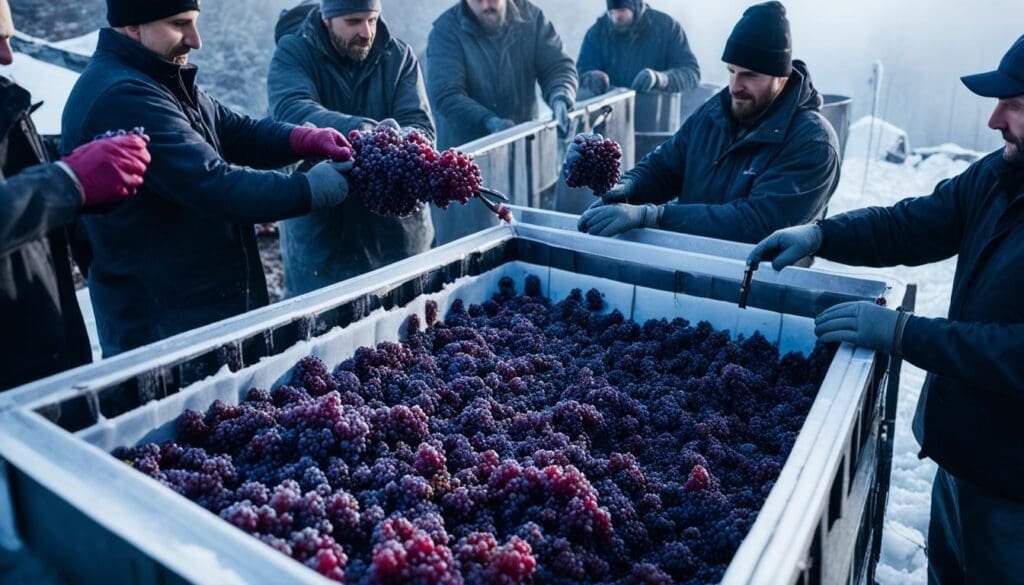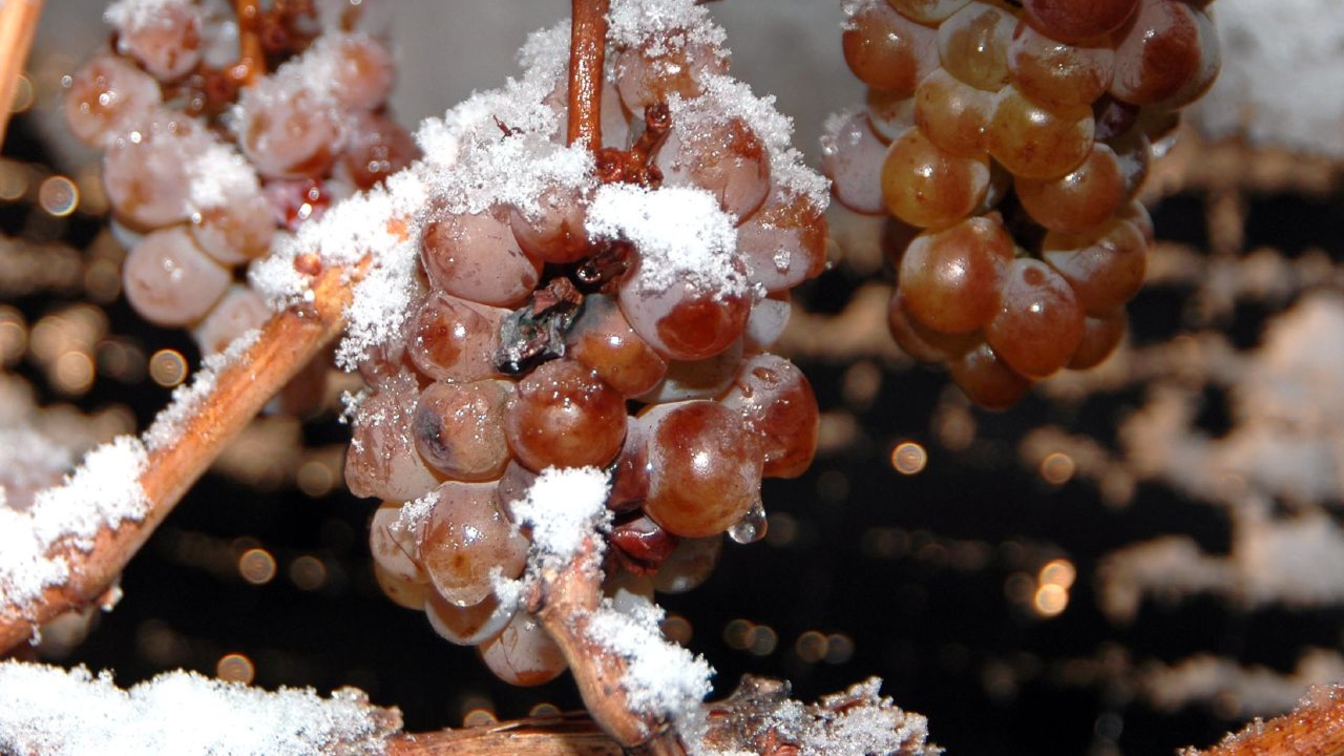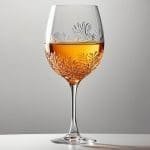Ever wondered what makes some dessert wines so sweet yet balanced? Welcome to the world of Icewine. What is Icewine?
It is made from frozen grapes, creating a unique mix of sweetness and acidity.
Icewine isn’t just any sweet wine. It’s a luxurious dessert wine with a careful making process. It starts in cold vineyards, like Canada’s, where grapes freeze naturally. Workers pick these frozen grapes in winter and press them while still frozen. The outcome is a very sweet juice that slowly becomes the rich icewine.
Want to know more about this unique frozen grape wine? We’ll talk about how it’s made and its special taste. Let’s explore the drink that’s a favorite of wine experts everywhere.
The Origins of Icewine
Icewine has captured hearts worldwide with its sweet, rich taste. But, do you know where it all began? This famous dessert wine has a story as interesting as its flavour. It started in Europe’s vineyards, then made its way to countries like Canada.
Historical Background
The story of icewine starts in 18th-century Germany, discovered by chance. Grapes left on the vine froze, and when pressed, they yielded a sweet juice. This juice, now known as eiswein, was sweet and rare, marking a new kind of wine.
Initially, making this wine was tough due to the weather. But, eventually, its rarity made it a luxurious drink for the elite.
The German Connection
Germany is crucial to icewine’s history. The name eiswein shows its strong link to German winemaking. They transformed a weather problem into a delicacy, showing their unmatched skill in wine.
Modern Commercial Production
The making of icewine kept getting better. New technology and strict rules improved the process. In places like Canada, makers still rely on the weather to freeze the grapes. This keeps the old tradition alive, staying close to how it all began in Germany.
The Unique Production Process of Icewine
Iced wines, like icewine, stand out because they aren’t made the usual way. The method needs very specific conditions to get its special sweet taste. We’ll look at how this luxury dessert wine is made in a unique way.
Harvesting Frozen Grapes
The journey to make icewine begins with the frozen grapes harvest. These grapes grow in places with cold winters. They’re left on the vines far longer than usual. Grapes are picked when it’s -8°C to -10°C, making sure the water inside is ice. This keeps all the sweet tastes locked in, setting the stage for that special flavor.

Pressing and Fermentation
After harvest, the frozen grapes are pressed. Being still frozen means they release a small amount of extra sweet juice. This juice, full of sugar, starts a wine fermentation process that’s very slow and can take months. This slow fermenting is key to icewine’s taste. It helps keep that sweet but balanced flavor. At this stage, everything is done very carefully to keep the wine’s texture and rich taste intact.
Balancing Sweetness and Acidity
Getting the sweetness and acidity right is crucial in making dessert wines, especially icewine. The grape’s natural sourness balances out its high sugar content. This makes each sip a pleasure, not too sweet but beautifully balanced. It’s this perfect mix that makes icewine so loved and special.
What is Icewine?
Icewine is a special type of luxurious dessert wine. It’s made from grapes that freeze on the vine. This process happens naturally during late harvest.
Its sweetness and high acidity come from the grapes’ concentrated sugars and flavors. When the grapes freeze, the water inside turns to ice. This creates icewine’s unique taste.
Icewine stands out because of its sweetness and beautiful smell. This perfect mix of sweet and sour makes it a drink of winter. It truly is a luxurious dessert wine.
Popular Varieties of Icewine Grapes
Icewine’s taste largely comes from the types of grapes used. Each grape kind gives icewine a special taste. This makes exploring icewine very interesting. Here are some well-liked icewine grapes:
Riesling
Riesling icewine has sharp acidity and bold fruit flavours. Riesling grapes are known for making rich, fragrant wines. They add a unique sweetness balance. In a good Riesling icewine, you might taste apricot, peach, and a touch of citrus.
Vidal Blanc
Vidal Blanc icewine is loved in cold areas for its resilience. Its thick skin can handle harsh freezes, producing a full-bodied wine. A glass of Vidal Blanc icewine offers sweet honey notes, along with tropical fruits like pineapple and mango. Its smooth finish is quite satisfying.
Cabernet Franc
Looking for a different choice? Try Cabernet Franc icewine for a unique experience. This red icewine mixes traditional sweetness with red grape flavours. You might taste red berries, cherry, and a bit of spice. It all comes together for a fresh, well-balanced icewine taste.
Discoering these icewine varieties helps you understand the wide range of grape flavours. Whether you like the zest of Riesling, the warmth of Vidal Blanc, or the fruity touch of Cabernet Franc, icewine has something for everyone.
Leading Regions for Icewine Production
Canada leads the world in icewine production. Its top regions have a perfect climate mix. They need warm summers to grow grapes and freezing winters to make icewine.
Niagara Peninsula, Ontario
The Niagara Peninsula makes great icewine. It has unique weather patterns ideal for icewine. This allows the grapes to naturally freeze and capture the region’s special taste.
Okanagan Valley, British Columbia
In British Columbia’s Okanagan Valley, you find top-notch icewine. The area’s variety of climates creates special flavours. This makes its icewine popular around the globe.
Other Notable Regions
Germany and Austria are also famous for icewine. They keep the Eiswein tradition alive. These areas add their own special tastes to the dessert wine world.
Challenges in Crafting Icewine
Producing icewine poses unique challenges for winemakers. Getting the right cold weather is essential. The grapes must freeze right on the vine to capture their sweetness. This makes the rich, sweet flavour of icewine.
The weather can be a winemaker’s worst enemy. It’s hard to pick the right time to harvest. Winemakers watch the weather closely. They wait for the perfect cold snap to pick the grapes.

Harvesting the grapes itself is a tough job. Workers go out in the middle of the night to pick them. They face icy conditions. This makes it a hard but vital part of the process.
Once the grapes are picked, more hard work begins in the winery. The grapes are pressed and fermented carefully. This process makes sure icewine keeps its sweetness and tartness. It shows the true artistry and effort of the winemaker.
Pairing Icewine with Food
Finding the best dessert wine pairings can make your meal extra special. Icewine stands out with its sweet taste and nice tang. It works well with many dishes, from regular desserts to unique savoury foods. The perfect food and wine pairing turns a regular meal into something amazing.
Traditional Dessert Pairings
With icewine pairing suggestions, go for the classics. Top choices include crème brûlée, vanilla panna cotta, or a rich cheesecake. These sweets mix well with the sugary flavour of icewine. They balance each other, making a delightful taste combination.
Unexpected Savoury Matches
Don’t just think about sweets. Icewine also goes with savoury meals. It’s perfect with foie gras, adding a sweet note to its buttery flavour. Even spicy Asian dishes match, as icewine’s tangy taste cools the heat. A strong blue cheese, too, complements it well. It adds a different flavour and texture.
Perfect Serving Temperature
Getting the right temperature for icewine is key for its dessert wine pairings. It should be about 10°C. Too warm, and it might feel too sweet. Too cold, and you might miss its rich taste. Also, avoid desserts that are sweeter than the icewine. This keeps a perfect taste balance.
Why Icewine is So Highly Prized
Icewine is a rare and luxurious drink. Making it is a hard and skilled task. It’s made in very cold conditions, which isn’t easy to find every year. Because of this, it becomes a very special type of dessert wine. Each bottle shows the hard work that went into it, and it tastes like a perfect mix of sweet and sour.
Drinking icewine means tasting more than just a sweet wine. You’ll smell and taste many interesting things. It’s special because it takes a lot of effort to make, and the flavors are unique. With every sip, you can feel the winter cold and the talent of the winemakers.
Icewine is loved not only for its taste and smell but also for its variety of flavors. You might taste tropical fruits, honey, or even flowers. This makes icewine more than a drink; it’s an experience worth celebrating. Drinking icewine is celebrating the best of nature and man’s creativity in making wine.
Frequently Asked Questions
What is icewine?
Icewine is a type of dessert wine. It’s made from grapes that freeze naturally on the vine. This creates a sweet and complex flavour. It’s known for its high sugar and acidity balance, offering a luscious taste.
What is the history of icewine?
Icewine started in 18th-century Germany. It was first made by accident. Cold weather made its production difficult. But with improved technology, making icewine became safer. Now, the Niagara Peninsula and the Okanagan Valley in Canada are known for it.
How is icewine produced?
Farmers harvest icewine grapes in very cold temperatures, ranging from -8°C to -10°C. The grapes need to stay frozen. They press these solid grapes to extract a juice rich in natural sugars. This juice ferments slowly for months. It keeps its sweet taste and acidity balance.
What grape varieties are commonly used for icewine?
Riesling, Vidal Blanc, and Cabernet Franc grapes are often used. Riesling provides bright acidity and fruitiness. Vidal Blanc brings honeyed and tropical flavours. Meanwhile, Cabernet Franc gives red icewine its unique character with cherry and berry hints.
Where is icewine commonly produced?
Canada is the top producer of icewine. The Niagara Peninsula and the Okanagan Valley are key areas. These places have the perfect weather for growing icewine grapes. This helps them make top-quality icewines.
What challenges are faced in crafting icewine?
Harvesting icewine grapes is very tough. The weather has to be cold enough to freeze the grapes. Workers pick these grapes in very cold conditions. It’s also hard to press and ferment the juice just right to keep its sweetness and acidity balanced.
What foods pair well with icewine?
Icewine goes well with sweet and savoury dishes. It’s great with fruit tarts, cheesecake, and foie gras. It also matches with spicy food and strong blue cheese. Serve it cool, at around 10°C, to enjoy its full flavour.
Why is icewine considered a luxury beverage?
Icewine is considered a luxury due to its rare and hard-to-make nature. The perfect mix of sweetness, aroma, and texture makes it special. It reflects the wonders of nature and the skill of winemakers.
Source Links
- https://mojavecider.com/blog/what-is-ice-wine-the-art-of-harvesting-frozen-grapes
- https://www.vinoble.org/en/blog/ice-wine-sweetness-frozen-grapes
- https://medium.com/@Vinerra/icewine-eiswein-in-depth-guide-68d3a0bec9f1
User Review
( votes)Sip smarter, subscribe now!
Subscribe for gourmet tips, event updates, travel ideas, and a free e-book on Food Pairings. Start your journey to culinary and travel excellence!













